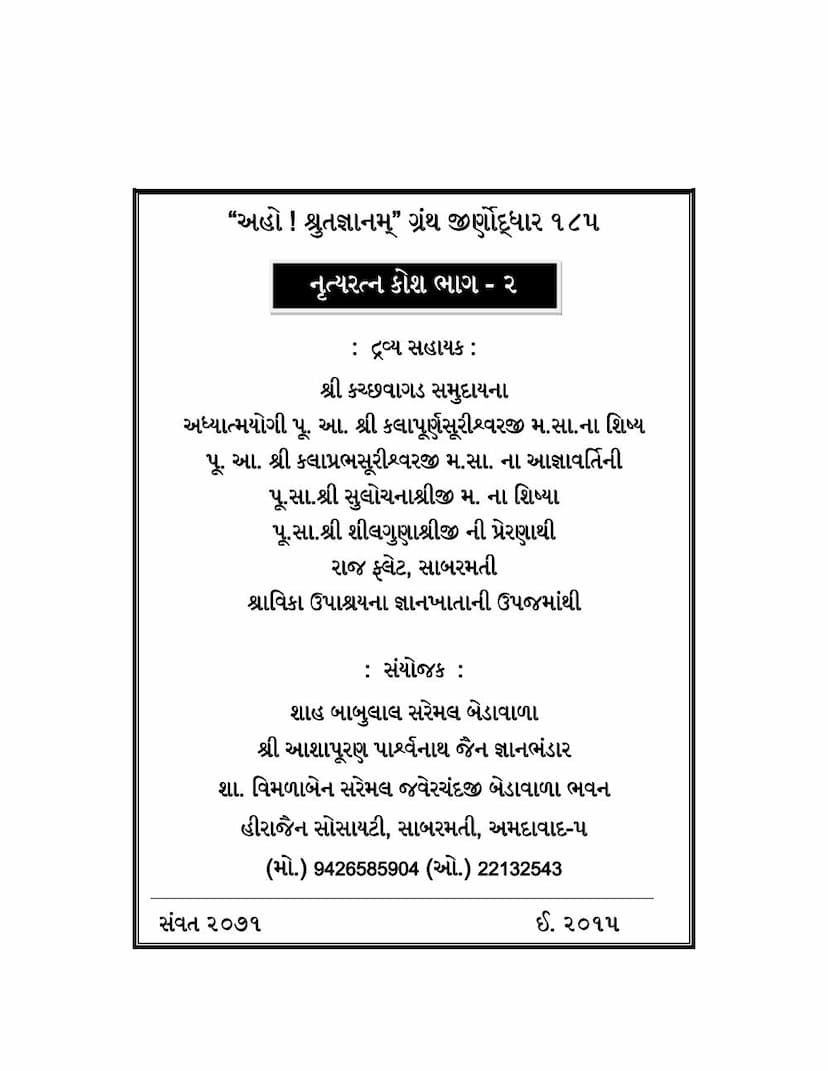Nrutyaratna Kosh Part 02
Added to library: September 2, 2025

Summary
Here's a comprehensive summary of the provided Jain text, "Nrutyaratna Kosh Part 02," based on the pages you've shared:
Title: Nrutyaratna Kosh Part 02 Author: Kumbhakarna Nrupati (Maharana Kumbha of Mewar) Publisher: Rajasthan Purattvanveshan Mandir Catalog Link: https://jainqq.org/explore/034222/1
Overall Purpose and Context:
This text is the second part of the "Nrutyaratna Kosh," which itself is a significant section of a larger, monumental work by Maharana Kumbha called "Samgitaraja" (also referred to as "Samgita-mimāṁsā"). The "Samgitaraja" is a comprehensive treatise on music, dance, and aesthetics, reportedly comprising 16,000 verses and divided into five "Ratnakosas" (Treasures): Pathyaratnakosa (lyrics/text), Gitaratnakosa (songs), Vadyaratnakosa (instruments), Nrutyaratnakosa (dance), and Rasaratnakosa (aesthetics/emotions).
The "Nrutyaratna Kosh Part 02" focuses specifically on the art and science of dance, detailing various aspects of classical Indian dance. The provided pages offer a glimpse into the meticulously organized content, which includes detailed classifications and descriptions of:
- Dance Movements (Karanas): The text provides an extensive list and descriptions of various dance movements, often categorized and named. These are meticulously detailed, with specific instructions on hand gestures, footwork, and body postures. The pages cover both "Shuddha Karanas" (pure/classical) and "Deshi Karanas" (regional/folkloric).
- Hand Gestures (Hastakas): Numerous hand gestures are described and classified, with specific names and their applications in dance.
- Footwork and Body Postures (Sthanakas, Charis, etc.): The text elaborates on different types of footwork, leg movements, hip movements, neck movements, arm positions, and overall body postures essential for dance.
- Facial Expressions and Emotions (Abhinaya, Rasas): It delves into the art of expression through facial movements, eye contact, and the representation of various emotions or "Rasas" (e.g., Shringara, Hasya, Karuna, Raudra, Veera, Bhayanaka, Bibhatsa, Adbhuta, Shanta).
- Costume and Makeup (Maharya Abhinaya): While less detailed in the provided excerpts, there's an indication of the importance of costume and ornamentation in portraying characters and enhancing the dance.
- Angaharas: These are described as sequences of movements and gestures forming a larger dance unit, often composed of several Karanas. The text details different types of Angaharas based on their composition and stylistic characteristics.
- Deshi Dances and Styles: The work acknowledges and describes various regional dance forms and styles, indicating a comprehensive approach to the subject.
- Structure and Organization: The "Nrutyaratna Kosh" is structured into "Ullāsas" (chapters) and "Parikshanas" (sections or tests within chapters), demonstrating a systematic and scholarly approach to presenting the complex information.
Authorship and Historical Context:
A significant portion of the introductory material (pages 13-44 and beyond) discusses the authorship of the "Samgitaraja" and, by extension, the "Nrutyaratna Kosh." There's a debate among scholars regarding whether the author was Maharana Kumbhakarna or a king named Kalasena. The consensus presented in the text, based on manuscript analysis, strongly favors Maharana Kumbha as the author.
The introduction highlights:
- Maharana Kumbha's Personality: He is portrayed not only as a renowned ruler, warrior, and builder but also as a prolific scholar, patron of arts, and a gifted thinker. His reign (mid-15th century) was a period of significant cultural and artistic flourishing in Mewar.
- Kumbha's Literary Contributions: Besides the "Samgitaraja," he is credited with commentaries on Gitagovinda ("Rasikapriya") and Candisataka, several dramas, and works on architecture.
- The "Samgitaraja" as a Multi-faceted Work: It's emphasized that "Samgitaraja" is more than just a textbook; it integrates music and dance with Vedic philosophy and aims to revive the tradition of "Natya Veda."
- The Debate on Kalasena: The text addresses the claims of Kalasena, presenting evidence from manuscripts that suggests Kalasena might have been a different person or a pseudonym. However, the stronger evidence points to Kumbha.
Key Details from the Provided Pages:
- Page 1: Indicates the publication details, including the year (Samvat 2071 / 2015 CE) and mentions financial support ("Dravya Sahayak") from the Shri Kachhvagad community and spiritual guidance from various esteemed monks and nuns.
- Pages 2-11 (and beyond): These pages contain a detailed index or catalog of numerous ancient texts that have been scanned and made available on DVD by the "Shri Ashapuran Parshvanath Jain Gyan Bhandar" as part of the "Aho Shrutgyanam Granth Jirnoddhar" project. This list is extensive and covers a wide range of subjects including scriptures, philosophy, grammar, astrology, architecture, and more, showcasing the Bhandar's commitment to preserving and digitizing valuable manuscripts. The "Nrutyaratna Kosh Part 02" is listed as a part of this larger preservation effort.
- Pages 12-19 (Introduction): These pages provide the bulk of the introductory information, focusing on the "Nrutyaratna Kosh" as part of "Samgitaraja," the debate on authorship between Kumbhakarna and Kalasena, and historical context surrounding Maharana Kumbha's life, reign, military campaigns, and patronage of arts.
- Pages 20-41 (Contents and Detailed Descriptions): These pages delve into the actual content of the "Nrutyaratna Kosh," outlining the chapters (Ullāsas) and sections (Parikshanas) and listing the specific dance techniques, movements, gestures, and their classifications. The detail is remarkable, covering hundreds of specific dance elements.
- Appendix I & II: These sections provide details about the manuscripts used for the edition of the "Nrutyaratna Kosh" and "Rasaratnakosa," as well as the genealogy and achievements of Maharana Kumbha and the conflicting claims of Kalasena.
In essence, "Nrutyaratna Kosh Part 02" is a highly specialized and scholarly work on classical Indian dance, authored by a prominent historical figure, Maharana Kumbha. It serves as a vital repository of knowledge on dance techniques, expressions, and theory, contributing significantly to the study of ancient Indian performing arts and cultural heritage.